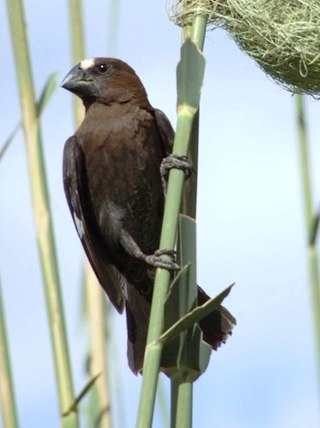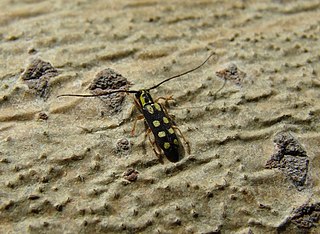
The greater white-fronted goose is a species of goose, closely related to the smaller lesser white-fronted goose. The greater white-fronted goose is migratory, breeding in northern Canada, Alaska, Greenland and Russia, and winters farther south in North America, Europe and Asia. It is named for the patch of white feathers bordering the base of its bill: albifrons comes from the Latin albus "white" and frons "forehead". In the United Kingdom and Ireland, it has been known as the white-fronted goose; in North America it is known as the greater white-fronted goose, and this name is also increasingly adopted internationally. Even more distinctive are the salt-and-pepper markings on the breast of adult birds, which is why the goose is colloquially called the "specklebelly" in North America.

The little tern is a seabird of the family Laridae. It was first described by the German naturalist Peter Simon Pallas in 1764 and given the binomial name Sterna albifrons. It was moved to the genus Sternula when the genus Sterna was restricted to the larger typical terns. The genus name Sternula is a diminutive of Sterna, 'tern', while the specific name albifrons is from Latin albus, 'white', and frons, 'forehead'.

The white-fronted amazon also known as the white-fronted parrot, or spectacled amazon parrot, is a Central American species of parrot. They can imitate a range from 30 to 40 different sounds. Like other large parrots, the white-fronted parrot has a long potential life span, usually around 40 years.

White-fronted capuchin can refer to any of a number of species of gracile capuchin monkey which used to be considered as the single species Cebus albifrons. White-fronted capuchins are found in seven different countries in South America: Bolivia, Brazil, Colombia, Venezuela, Ecuador, Peru, and Trinidad and Tobago.

Squalus albifrons, the eastern highfin spurdog, is a dogfish described in 2007. It is a member of the family Squalidae, found on the continental shelf off Queensland, Australia, at depths between 220 and 510 m. The length of the longest specimen measured is 65 cm (26 in). Its reproduction is ovoviviparous.

The thick-billed weaver, or grosbeak weaver, is a distinctive and bold species of weaver bird that is native to the Afrotropics. It belongs to the monotypic genus Amblyospiza and subfamily Amblyospizinae.

The white-fronted chat is a species of bird in the honeyeater family Meliphagidae native to southern Australia. The male has a white face bordered by a black breast band. It is insectivorous.

Gracile capuchin monkeys are capuchin monkeys in the genus Cebus. At one time all capuchin monkeys were included within the genus Cebus. In 2011, Jessica Lynch Alfaro et al. proposed splitting the genus between the robust capuchin monkeys, such as the tufted capuchin, and the gracile capuchins. The gracile capuchins retain the genus name Cebus, while the robust species have been transferred to Sapajus.

Saperdini is a tribe of longhorn beetles of the subfamily Lamiinae.

Menesia is a genus of longhorn beetles of the subfamily Lamiinae, containing the following species:
Menesia bimaculata is a species of beetle in the family Cerambycidae. It was described by Stephan von Breuning in 1954. It is known from Borneo.
Menesia burmanensis is a species of beetle in the family Cerambycidae. It was described by Stephan von Breuning in 1954.
Menesia javanica is a species of beetle in the family Cerambycidae. It was described by Stephan von Breuning in 1954. It is known from Java.
Menesia nigriceps is a species of beetle in the family Cerambycidae. It was described by Per Olof Christopher Aurivillius in 1903. It contains the varietas Menesia nigriceps var. inhumeralis.
Menesia nigricornis is a species of beetle in the family Cerambycidae. It was described by Per Olof Christopher Aurivillius in 1913. It is known from Borneo.
Menesia sexvittata is a species of beetle in the family Cerambycidae. It was described by Stephan von Breuning in 1962. It is known from Java.
Menesia walshae is a species of beetle in the family Cerambycidae. It was described by Stephan von Breuning in 1960. It is known from Java.

Menesia bipunctata is a species of beetle in the family Cerambycidae. It was described by Zoubkov in 1829, originally under the genus Saperda. It has a wide distribution in Europe and Asia. It measures between 6 and 9 mm. It feeds on Juglans regia and Frangula alnus.

Menesia sulphurata is a species of beetle in the family Cerambycidae. It was described by Gebler in 1825, originally under the genus Saperda. It is known from Mongolia, Kazakhstan, Japan, China, and Russia.
Menesia transversenotata is a species of beetle in the family Cerambycidae. It was described by Heller in 1924. It is known from the Philippines.










